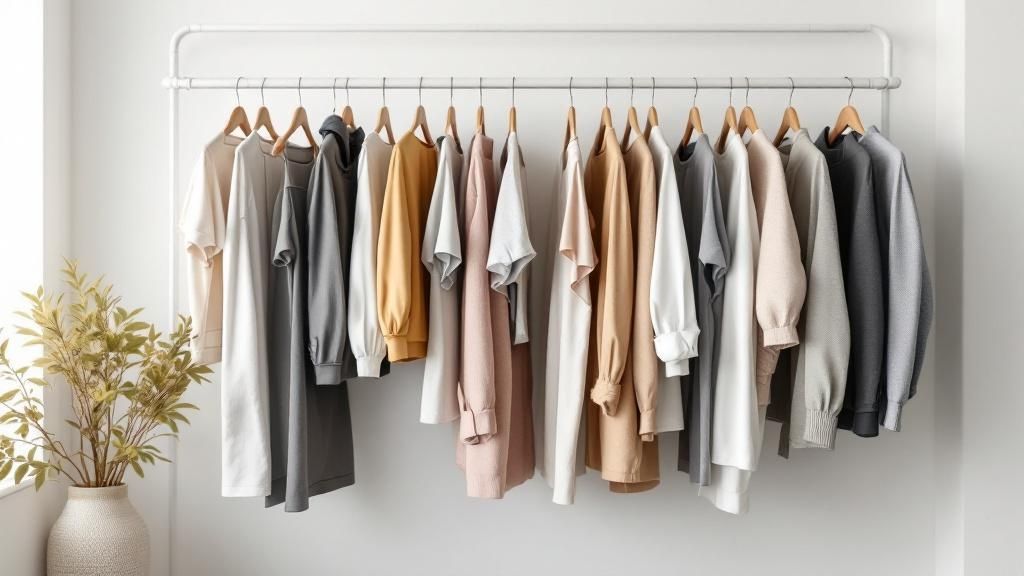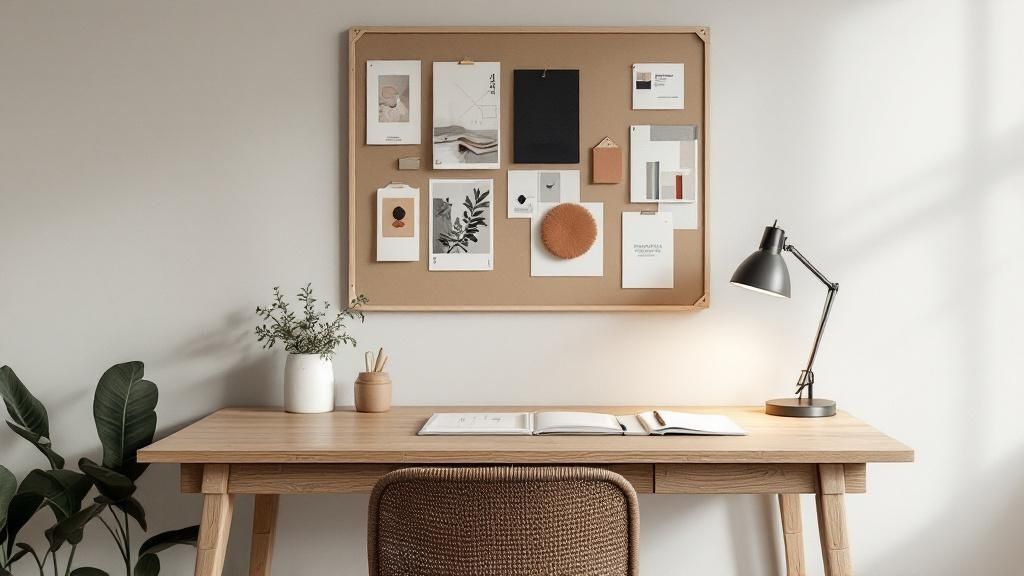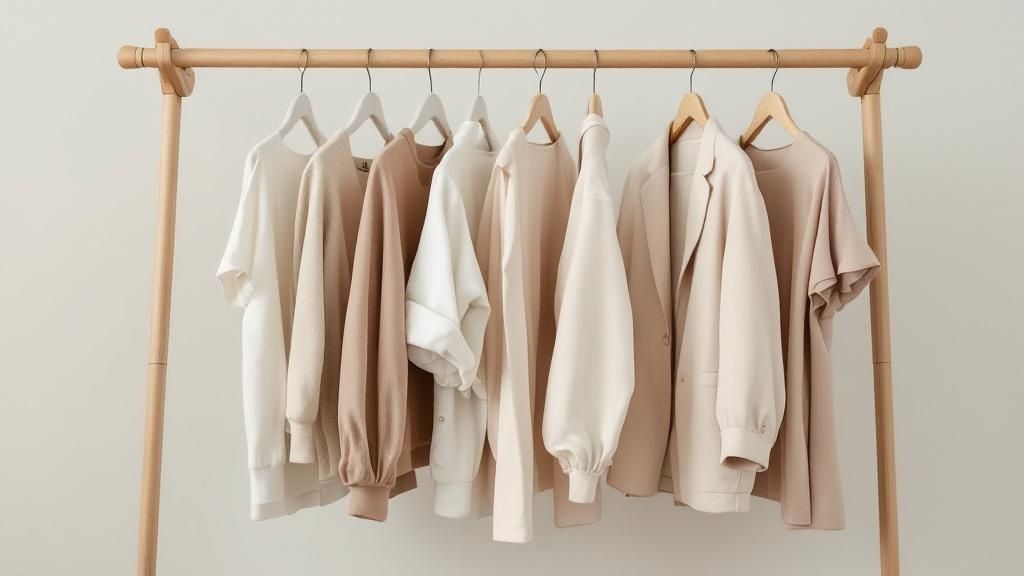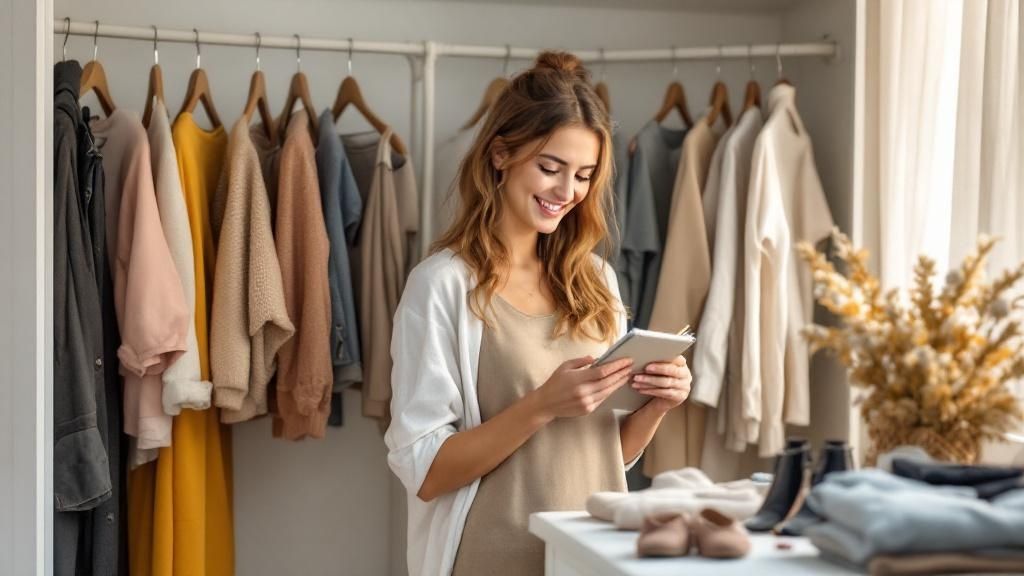Understanding What Style Actually Means For You
Before you even think about purging your closet or hitting the shops, let's get something straight: personal style is not the same as fashion. Fashion is what designers send down the runway each season—fleeting trends and of-the-moment looks. Style, on the other hand, is your personal story. It’s the narrative you tell the world without saying a word, an authentic reflection of who you are, what you value, and how you want to feel. It’s why some people look effortlessly magnetic in a simple t-shirt and jeans, while others seem lost in a wardrobe full of trendy, expensive items.
Your best look should feel like the truest version of yourself. Since genuine style is so personal, the first step to finding it is to look inward. Before you can define your external appearance, it's essential to understand your inner world. For anyone ready to dig deeper, exploring tips on how to become more self-aware and embark on a journey of self-discovery can provide a solid foundation for this process. This self-knowledge is what turns dressing from a daily chore into a joyful act.
Fashion vs. Style: The Core Difference
Think of fashion as a massive, ever-changing library of clothing, while style is the specific collection of books you choose to read and display. Fashion is influenced by broad cultural shifts. For instance, social media is a huge driver, with 78% of consumers admitting their choices are influenced by platforms like Instagram and TikTok. Likewise, the growing integration of wearable technology—expected to be in 27.2% of U.S. wardrobes by 2025—shows a collective move toward functional, tech-infused apparel. These trends offer options, but your personal style is about which of these options you intentionally select to align with your identity. You can learn more about these fascinating cultural impacts by exploring the full statistics on fashion trends.
Your style is less about what’s new and more about what’s you. It’s a curated mix of silhouettes, colors, and textures that simply feel like home. This is precisely why copying a celebrity's outfit piece-for-piece often feels hollow—you're borrowing their story instead of telling your own. The real goal is to build a wardrobe that supports your actual life: your career, your weekend plans, your comfort, and your confidence.
Identifying Your Style Influences
So, where does inspiration come from? It's all around you, but the key is to analyze, not just admire.
The table below breaks down the common sources that shape our style, helping you understand where your own preferences might be coming from.
| Influence Type | Impact Level | Authenticity Factor | Longevity |
|---|---|---|---|
| Social Media Trends | High | Low | Short-Term |
| Celebrity Looks | High | Medium | Varies |
| Personal Experiences | Medium | High | Long-Term |
| Art & Culture | Medium | High | Long-Term |
| Peer Groups | High | Varies | Varies |
| Family Upbringing | Medium | Medium | Long-Term |
This comparison highlights that while trends on social media can be fun, the most authentic and lasting style influences often come from more personal sources like your own experiences or cultural interests.
Here's a look at how you might gather inspiration from a platform like Pinterest.
This visual collection shows a variety of aesthetics, from minimalist neutrals to bold, layered looks, highlighting how "personal style" can mean many different things. The key insight here is recognizing recurring themes. Do you consistently pin tailored blazers, relaxed-fit denim, or vibrant colors? These patterns are clues to your inherent preferences, pointing you toward a style that feels genuinely your own.
Taking An Honest Look At Your Current Wardrobe
It's time for some radical honesty about what’s actually hanging in your closet. Before you can truly define your style, you need a clear-eyed view of your starting point. This isn't about judging past purchases; think of it as a strategic audit to understand what’s working, what isn’t, and most importantly, why. Many of us hold onto pieces for sentimental reasons or "just in case" scenarios, but this only creates clutter, making it harder to see what you genuinely love.
This process of analysis is all about connecting your personal identity to your clothing, as shown in the visualization below.
This simple flow illustrates that your personal style comes from the intersection of who you are, what you do, and what you find beautiful. Taking stock of your current wardrobe is a practical way to test your clothes against these very criteria.
The Great Wardrobe Sort
Let's get started. Pull everything out of your closet—yes, I mean everything. Create three distinct piles based on your immediate emotional reaction to each item:
- The "Love It" Pile: These are your champions. The pieces you reach for constantly, the ones that make you feel confident and comfortable the moment you put them on. Don't overthink it; this is a gut-feeling category.
- The "Maybe" Pile: This is for items that give you pause. Maybe the fit is slightly off, the color feels unflattering, or it’s a piece you like in theory but never seem to wear. These are your mystery items that require a little more investigation.
- The "Let It Go" Pile: This includes anything that makes you feel "meh," doesn’t fit, is damaged beyond repair, or simply belongs to a past version of yourself. Be ruthless here. Holding onto these pieces only takes up valuable physical and mental space.
Digging Deeper Into The "Maybe" Pile
The "maybe" pile is where the real learning happens. For each item, ask yourself why it isn't a definite yes. Is it uncomfortable? Does it feel like you're wearing a costume? Does it fail to pair well with anything else you own? Recognizing these hang-ups reveals important data about your preferences. You might realize you dislike restrictive fabrics or fussy details, which can guide you toward more streamlined choices in the future.
This introspective process is also shaped by wider economic feelings. With consumer sentiment in flux, shoppers are becoming more deliberate. Recent industry analysis from McKinsey's State of Fashion 2025 report shows that with 39% of fashion leaders anticipating worsening economic conditions, people are naturally more cautious with their purchases. This mindset makes a thorough wardrobe audit even more crucial; it ensures any new additions are intentional investments, not impulsive buys you'll regret later. By being honest about what you already own, you’re setting the stage for smarter, more satisfying choices that truly reflect your emerging style.
Gathering Style Inspiration That Actually Works

After an honest closet audit, you have a much better handle on what you own. But what about the style you want to have? This is where finding inspiration comes in, but we're not talking about the kind that leaves you with thousands of pretty pictures and zero real-life outfits. The goal here is to move past mindlessly saving images and start actively figuring out why certain looks catch your eye. It's the difference between admiring a beautiful meal at a restaurant and actually learning the recipe to make it yourself.
A common trap is pinning outfits that look incredible on a model but don't quite fit your body, budget, or day-to-day reality. To sidestep this, try shifting your focus from the person in the photo to the specific elements of the outfit. Is it the unexpected color pairing? The sharp silhouette of the trousers? Maybe it's the rich texture of the knitwear. This analytical eye is what turns a pretty picture into a tangible part of your wardrobe.
Decoding Your Digital Mood Board
Start by creating a dedicated space for your inspiration, whether that’s a Pinterest board or just a folder on your phone. As you begin saving images, pause and look for the patterns that emerge. Are you consistently drawn to:
- Specific Silhouettes? You might notice a lot of wide-leg trousers, A-line skirts, or sharply tailored blazers popping up.
- A Particular Color Palette? Perhaps your board is a sea of earthy tones, vibrant jewel colors, or classic monochromatic black and white.
- Certain Textures and Fabrics? You could find that your collection is filled with chunky knits, sleek silks, or structured denim.
These recurring themes are the true building blocks of your personal style. They reveal your subconscious preferences, which are often subtly shaped by broader fashion movements. For instance, data analytics can show how certain details gain traction. In 2025, forecasts pointed to an 8% increase in turquoise shades and a 20% growth in mermaid-inspired elements like sequins. This shows how specific aesthetics can gather momentum. If you're curious about how data influences what we see, you can explore the full 2025 fashion trend forecast.
From Inspiration to Action
Once you've spotted these patterns in your mood board, it's time to test them out in the real world. You don't need to rush out and buy something new immediately. Instead, challenge yourself to recreate the vibe of an outfit you love using pieces you already own.
If you've saved a dozen tailored looks, try pairing that blazer you have with different trousers or jeans. If you find yourself drawn to a new color, see if you can introduce it through a simple accessory like a scarf or a handbag. This hands-on experimentation is how you figure out how to find your style in a way that feels authentic, practical, and genuinely works for you.
Defining Your Style Goals Within Real Life Constraints

So, your mood board is bursting with incredible style inspiration. That's a fantastic start, but let's be honest: a truly great personal style has to work for the life you actually live, not some fantasy version of it. The real secret to learning how to find your style is building a bridge between your aspirations and your day-to-day reality. This means setting style goals that consider your career, social circle, daily grind, and, of course, your budget. It’s all about finding that perfect intersection where polished meets practical.
Think of your life as a pie chart. Which activities take up the biggest slices? For many of us, work is the largest piece. If you’re a corporate lawyer, your daily style needs are worlds away from those of a freelance graphic designer working from a home studio. Being realistic is everything here. You might adore the idea of delicate silk blouses, but if your weekends involve chasing after toddlers, focusing on durable, washable fabrics is a much smarter move.
Balancing Aspirations with Reality
To make your goals stick, we need to get practical. Your personal style should be a supportive character in your life story, not a source of stress or frustration. Begin by identifying the top three areas where you want your style to make a real impact. Maybe it's feeling more authoritative at work, looking effortlessly chic on the weekends, or simply having go-to outfits ready for social events. As you clarify this vision, you'll also learn how to tweak your aesthetic for different situations, from casual coffee runs to more formal events like those you might find in guides on Dressing for Special Occasions.
By zeroing in on these priority areas first, you can channel your energy and budget where they’ll have the biggest effect. This focused approach saves you from the overwhelm of trying to reinvent your entire wardrobe at once. To help you organize this process, here’s a table that breaks down how different lifestyle needs can shape your priorities.
| Lifestyle Factor | Style Priority | Budget Allocation | Time Investment |
|---|---|---|---|
| Professional Life | Building a core of polished, high-quality, and comfortable workwear that projects confidence. | High | Medium |
| Social Outings | Curating expressive, fun, and on-trend pieces that showcase your personality. | Medium | Low |
| Weekend & Casual Wear | Investing in durable, comfortable, and versatile basics that can be mixed and matched. | Low | High (in frequency of wear) |
| Special Occasions | Acquiring a few elegant, timeless outfits for weddings, galas, and formal events. | Varies | Low |
This framework is designed to help you make intentional decisions, making sure every piece you consider adding to your closet serves a genuine purpose.
Ultimately, the goal is a wardrobe that works for the life you have right now, empowering you to feel confident and completely yourself, every single day.
Shopping With Intention Instead Of Impulse
The final piece of the puzzle in figuring out **how to find your style** isn’t found in a store—it happens in your mind. It’s about making a conscious shift from buying things on a whim to carefully curating a wardrobe you love. After all the self-reflection and gathering inspiration, the aim is to make every new purchase a confident move toward your style identity, not a random detour that just adds more clutter. This is where you learn to shop like a stylist, armed with a clear vision and a game plan.
One of the most effective habits you can build is to shop your own closet first. Before you even consider buying something new, give yourself a little challenge: create one new outfit using only items from your "love it" and "maybe" piles. This simple exercise sparks creativity and often helps you rediscover hidden gems you’ve completely forgotten about. It’s a zero-cost way to experiment with your new style goals. You might find that the blazer you were on the fence about looks amazing with a pair of jeans you already adore, instantly solving a style dilemma without spending a penny.
The Three-Question Framework for New Purchases
When you do decide it's time to shop, whether you're browsing in-store or online, it pays to have a mental checklist. Run every potential purchase through this simple decision-making framework before you commit.
- Does this fit the life I actually live? That gorgeous sequin top is a showstopper, but if your day-to-day involves office work and casual weekends, how often will it really see the light of day? Be brutally honest with yourself about practicality.
- Can I create at least three distinct outfits with it using pieces I already own? A truly great addition should slide right into your current wardrobe. If an item only works with one specific pair of trousers you own, it's probably not a smart investment for versatility.
- Does this make me feel like the most confident version of myself? This is the most important question. If you feel hesitant, uncomfortable, or like you're playing a character, it's a definite no. Your true style should feel like a second skin.
This mindful approach changes shopping from a quest for a quick fix into a thoughtful process of building a wardrobe that works together and lasts. It's how you escape that classic "closet full of clothes but nothing to wear" trap. Every piece you bring home should be a "heck yes," not just a "good enough for now." While you're shopping, especially online, it's also smart to keep your information safe. For more on this, our guide on how to shop safely online offers some great tips.
This deliberate method is especially useful during sales. A 50% off sticker is hard to resist, but a discount on something you don’t genuinely need or love is still wasted money. Stick to your list and your style vision. Over time, this conscious approach will help you gradually invest in higher-quality, timeless pieces that elevate your entire look and serve you for years, building a wardrobe that is both beautiful and genuinely you.
Experimenting While Staying True To Yourself

Finding your signature style is a creative process, not a rigid assignment with a deadline. It’s less about a dramatic, overnight makeover and more like an artist slowly developing their voice. The idea is to gently nudge your own boundaries and try new things while staying grounded in what feels genuinely you. Your goal should be to evolve your look, not to slip into a persona that feels like a costume. A great style experiment should feel like a more confident version of yourself, not a stranger in the mirror.
This is where the journey gets really fun. Once you have your inspiration and style goals in mind, you can start putting your ideas to the test. The trick is to begin with small, manageable changes. You don't need to jump from a minimalist, all-neutral wardrobe to head-to-toe neon in a single afternoon. A much better approach is to introduce one new element at a time, using a method I call the swap trick. This lets you ease into a fresh look without feeling overwhelmed.
Putting Small-Scale Experiments into Practice
The swap trick is a simple yet powerful way to step just outside your comfort zone. It's all about changing just one piece of an otherwise familiar outfit to see how it feels. Here’s how you can do it:
- Introduce a New Color: If your wardrobe is a fortress of black, white, and navy, try swapping your usual white blouse for one in a deep burgundy or a sophisticated olive green. Notice how it pairs with your favorite trousers or jeans.
- Play with Silhouettes: Do you live in skinny jeans? Give a well-fitting pair of straight-leg or wide-leg trousers a try with your go-to knit sweater. You might be surprised how a simple change in shape can update your entire look.
- Experiment with Texture: If your style leans classic and simple, introduce a single piece with a rich texture. Think about adding a velvet blazer or a silk camisole to an outfit you already know and love.
Handling a Style Misfire
Let's be realistic: not every experiment is going to be a roaring success, and that is completely okay. Some outfits simply look better in our heads than they do in real life. When a new combination doesn't work, don't write it off as a failure. Instead, think of it as collecting useful data. Ask yourself why it felt off. Was the color unflattering against your skin tone? Did the silhouette make you feel awkward or uncomfortable? Understanding what you don't like is just as important as pinpointing what you do.
Every attempt, whether it works or not, helps sharpen your personal taste. The goal is progress, not perfection. Even the most stylish people have had their share of fashion blunders. The difference is they use those moments as learning opportunities to refine their aesthetic even further. Embrace the entire process with curiosity, and you’ll discover that figuring out how to find your style is an enjoyable and deeply personal adventure.
Key Takeaways For Your Style Journey
Discovering your personal style is a continuous conversation with yourself, not a finish line you cross one day. It’s about constantly refining what makes you feel powerful and true to who you are. The real journey starts now: keeping that confidence alive, evolving gracefully, and finding inspiration without getting sidetracked by every passing trend. Think of your style as a muscle—it grows stronger with regular practice and thoughtful choices.
Your Roadmap for Lasting Style
To keep your style evolution on course, approach it like any other form of personal development. Consistent check-ins and a clear strategy will stop you from sliding back into old habits like impulse shopping or feeling lost in your own closet. The aim is to build a sustainable practice that truly celebrates you.
- Schedule a Quarterly Style Check-In: Treat it like a personal performance review. Set aside 30 minutes every three months to look at your wardrobe with fresh eyes. What have you been reaching for constantly? What’s just gathering dust? Does your closet still reflect your current life and goals? This simple habit prevents the slow creep of closet chaos.
- Handle Opinions with Grace: As you start to express your new style, comments will follow—some glowing, some maybe not so much. Remember, your style tells your story. Acknowledge the feedback, but don’t let it throw you off. Your confidence is your best accessory.
- Update Strategically, Not Impulsively: Instead of a seasonal wardrobe overhaul, concentrate on adding one or two high-quality pieces that enhance your core look. This could be a blazer that fits you perfectly or a pair of timeless leather boots. This mindful approach builds a more cohesive and durable collection over time.
Staying Inspired Authentically
Genuine style isn’t about copying someone else’s look; it’s about filtering inspiration through your own unique perspective. You don't just replicate an artist's painting; you learn their techniques and apply them to your own canvas.
- Analyze, Don't Just Admire: When an outfit catches your eye, break it down. Is it the blend of colors? The silhouette? The mix of textures? Pinpoint the exact elements that you connect with and think about how to bring that feeling into your own outfits with pieces you already own or plan to acquire.
- The One-Swap Rule: A great way to experiment without feeling like you've lost your way is to change just one thing in an outfit you already trust. Try swapping your go-to jeans for a pair of tailored trousers, or switch your neutral sweater for one in a striking color. This is how you grow without losing yourself.
Your style journey is about curating a wardrobe that doesn’t just look incredible but feels like a natural extension of who you are. For those ready to explore and invest in pieces that honor this new clarity, theFeinheit provides a thoughtfully selected collection where quality craftsmanship and authentic design meet. Discover pieces that will champion your style for years to come.
Discover more from theFeinheit
Subscribe to get the latest posts sent to your email.

